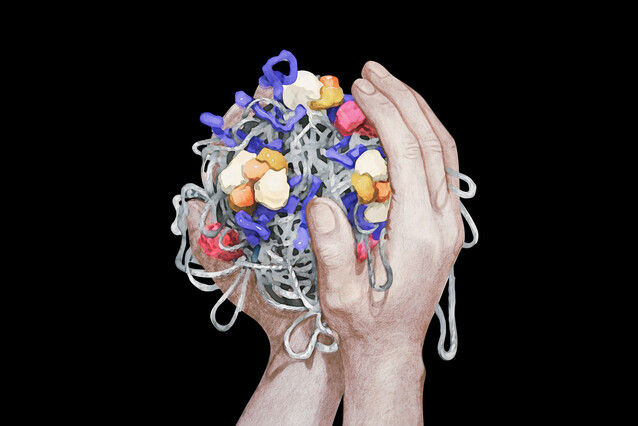From a loose string to a compact globule: scientists reshape our understanding of messenger RNA

Messenger RNA (mRNA) is the universal blueprint for protein production. Biology textbooks often depict mRNAs as an extended, string-like molecule that slithers out of the cell nucleus into the cytoplasm to be translated into a protein. However, making an mRNA is an extremely complex process that involves many steps, and each step must be perfectly executed to make the correct protein blueprint. How cells ensure that only correct mRNAs are allowed to leave the nucleus has been a black box for decades. In a study now published in the journal Nature, scientists in the lab of Clemens Plaschka investigated how correct mRNAs are identified and prepared for nuclear export. Their study also shows that mRNAs form compact globules before they exit the nucleus. These findings revise our understanding of mRNA and pave the way for further investigations of the life cycle of mRNA.
The information needed to make a cell is encoded in its DNA and stored inside the cell nucleus. Three complex steps are needed to interpret that information. First, a specific region of the genome is transcribed into an mRNA copy. Second, this newly made mRNA must mature to produce the correct blueprint for the third step, its translation into the protein. Proteins are key elements of life and do most of the heavy lifting in a cell, from moving other molecules around and transmitting information to catalysing chemical reactions and forming vital cellular structures.
In all eukaryotic cells, transcription and translation are physically separated: the former in the nucleus, and the latter in the cytoplasm. This separation ensures that nuclear transcription and processing can be completed before translation begins. While transcription and translation have received a lot of attention from molecular biologists, the stages in between, the maturation and export of mRNA from nucleus to cytoplasm, have remained a mystery. How is the mature mRNA recognised and prepared for its journey into the cytoplasm?
Scientists in the lab of Clemens Plaschka at the IMP have investigated this question using cutting-edge cryo-electron microscopy and tomography. Combining in vitro approaches with nuclear cell extracts, they offer new insights into mRNA packaging and export, now published in the journal Nature.
How mRNAs mature before they exit the nucleus
“A human cell produces up to 20,000 mRNAs that vary in sequence and in length. Among those, only fully processed mRNAs should be sent out of the nucleus,” explains Belén Pacheco-Fiallos, co-first author and a student in the Vienna BioCenter PhD Program. “Evolution has come up with a system that recognises all these different mRNAs in the nucleus, but only selects and sends out mRNAs that have completed their processing.”
mRNA transcripts go through a complex sequence of maturation events before they are exported to the cytoplasm; after each maturation event is completed, a unique set of proteins bind the mRNA molecule, giving it a green light for the next steps, in what could be called a three-dimensional checklist.
“The key to mRNA export is that the mRNA sequence itself isn’t a criterion for export – it’s the proteins that bind the mRNA that matter, because they signal the mRNA’s state of maturation,” says Matthias Vorländer, co-first author and postdoc in the Plaschka lab.

Rethinking mRNA into a globular structure
“mRNAs are very long molecules. Imagine a 50-metre string of Christmas lights stored in your basement that you want to carry to your living room and disentangle before use. Having it neatly packed and well organised in a box makes the process much easier and prevents the cable from getting caught in other items in your house,” says Vorländer. “Our results suggest that the TRanscription and EXport complex, or TREX for short, helps pack and organise mRNAs before they are exported out of the nucleus.”
TREX is a large protein complex that recognises and binds different markers of mature mRNAs simultaneously. The scientists found that one of the subunits of TREX, called ALYREF, is key to initiating the recognition of mature mRNAs.
In a first step, many ALYREF proteins bind maturation marks on the mRNA molecule – one ALYREF can attach several marks spread across the mRNA, bringing distant segments closer together and possibly compacting the molecule into an organised bundle. In a second step, ALYREF molecules recruit the rest of the TREX complexes to form a protective coat around the mRNA bundle.
“Our work updates the text-book view of mRNA: from a squiggly line to a compact, globular structure with implications for mRNA biogenesis, transport, and decay,” says Clemens Plaschka. “DNA folding and cohesin research at the IMP and beyond has impacted two decades of genome architecture studies. We hope that these new models for the three-dimensional organisation of mRNA will similarly impact research in RNA biology.”
Original publication
Belén Pacheco-Fiallos*, Matthias K. Vorländer*, Daria Riabov-Bassat, Laura Fin, Francis J. O’Reilly, Farja I. Ayala, Ulla Schellhaas, Juri Rappsilber, and Clemens Plaschka: “mRNA recognition and packaging by the human transcription-export complex”. Nature (2023), DOI: 10.1038/s41586-023-05904-0.
*These authors contributed equally.
About the Vienna BioCenter PhD Program
Much of the work underlying this publication was done by a doctoral student of the Vienna BioCenter PhD Program. Are you interested in a world-class career in molecular biology? Find out more: https://training.vbc.ac.at/phd-program/
IMP Mini Lecture | Clemens Plaschka
We use a YouTube plugin to display social media content on this page, which places requests to YouTube servers. These requests make your IP address visible to YouTube, who may use it in accordance with their data privacy policy. Please agree to make the YouTube video visible. You can find more information in our privacy settings.
Accept